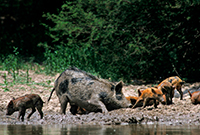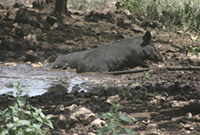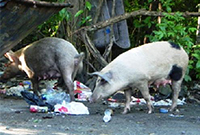TEXAS
WILD PIG
INVASION
HOUSTON, WE HAVE A PROBLEM
Pigs (Sus scrofa) are not native to North America. The species was first introduced to the West Indies by Christopher Columbus in 1493 and then to the continental United States by Spanish explorer Hernando de Soto in 1539 when he landed at the Florida coast. Domestic pigs were often carried on these excursions as a sustainable, low maintenance source of food. In addition to these feral pigs, Eurasian wild boar have been imported and released as an exotic game species for recreational hunting purposes across the United States since the early 1900s.
Today’s free-range pig population in the United States is made up of feral pigs, Eurasian wild boar, and hybrid populations resulting from cross-breeding of Eurasian wild boar and feral pigs. Though there are morphological differences among the three, they are all referred to by the same scientific name and all recognized as exotic invasive species in the United States.
The areas of focus are: Population/Reproduction, Resources, Damage/Disease and Population Control methods.
OVERPOPULATION:

There are as many as 9 million feral swine across the U.S., their populations having expanded from about 17 states to at least 39 over the last three decades. Canada doesn’t have comparable data, but Ryan Brook, a University of Saskatchewan biologist who researches wild pigs, predicts that they’ll occupy 386,000 square miles across the country by the end of 2020, and they’re currently expanding at about 35,000 square miles a year.
DAMAGE/DISEASE:

Feral hogs cause an average of $52 million of damage annually to the agricultural industry in Texas. This estimate does not account for growing feral hog damage in suburban areas.
Examples of feral hog damage include but are not limited to: rooting pastures and rangeland, consumption of native vegetation, negative effects on water quality, and predation of wildlife.
CONSUMPTION:

Wild hogs are “opportunistic omnivores,” meaning they’ll eat most anything. Using their extra-long snouts, flattened and strengthened on the end by a plate of cartilage, they can root as deep as three feet. They’ll devour or destroy whole fields-of sorghum, rice, wheat, soybeans, potatoes, melons and other fruits, nuts, grass and hay. Farmers planting corn have discovered that the hogs go methodically down the rows during the night, extracting seeds one by one.
CONTROL:

Effective fencing is one method of eliminating wild pig damage and reducing economic impact on valuable agricultural land or where other control techniques are not possible.
For exclusion fences for hogs and wild pigs to be successful, the fences need to be made of special high tensile wire installed in a way that leverages the strength of the wire with strong structural members at corners, gates and terminal posts and points.
